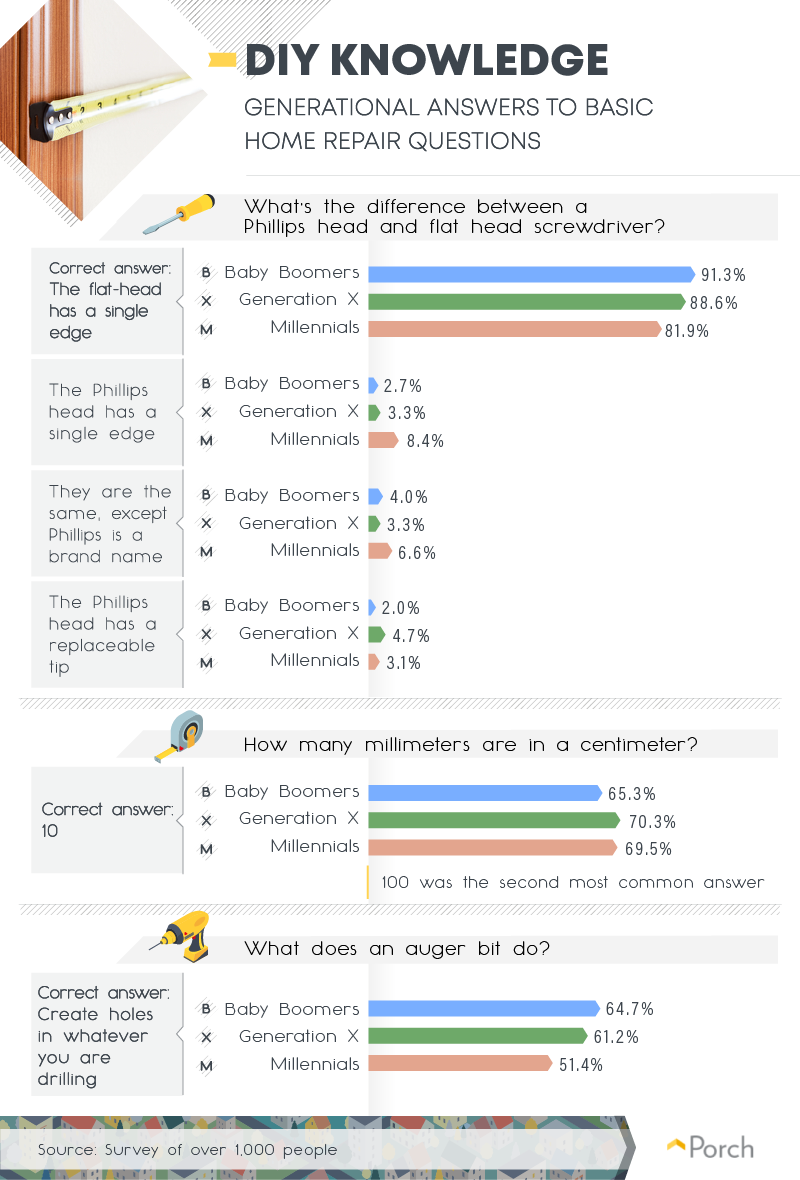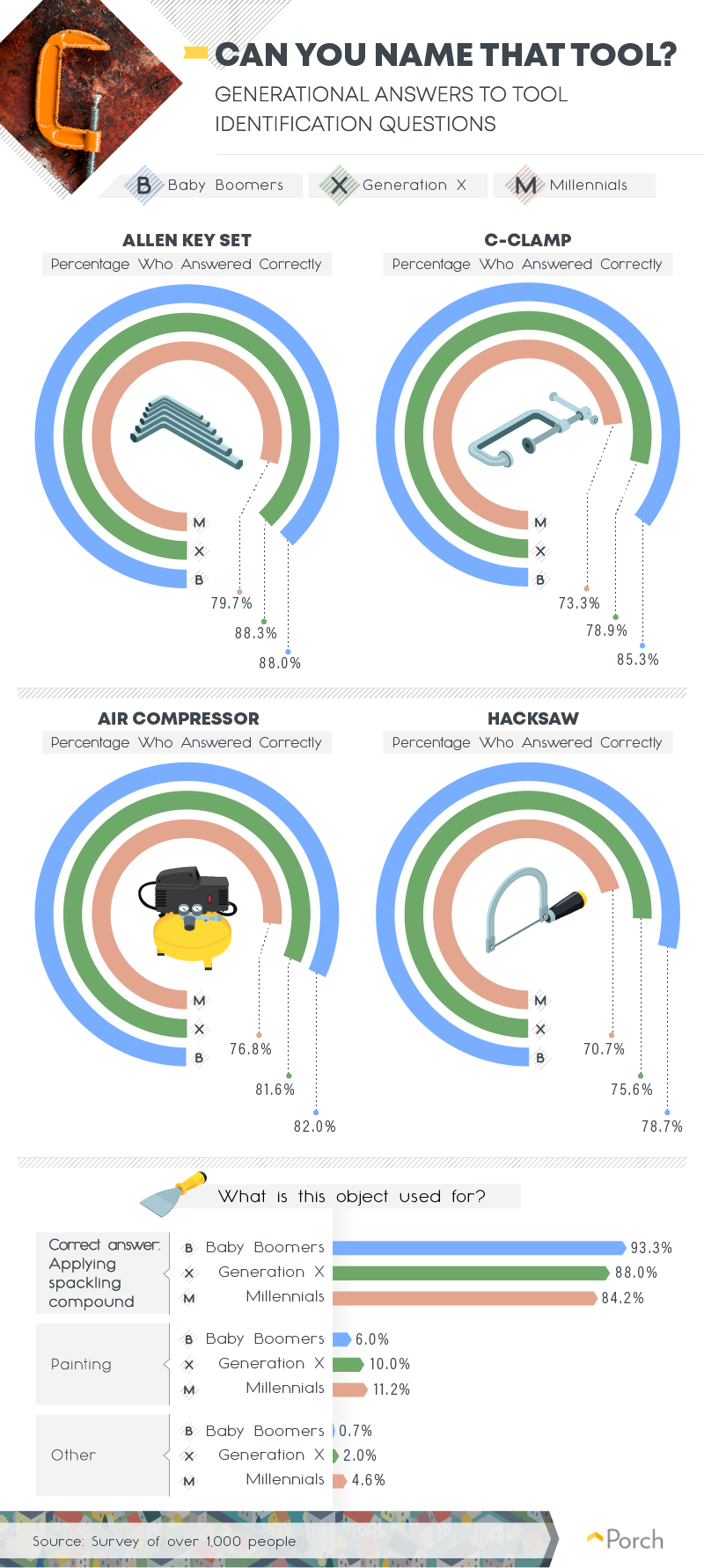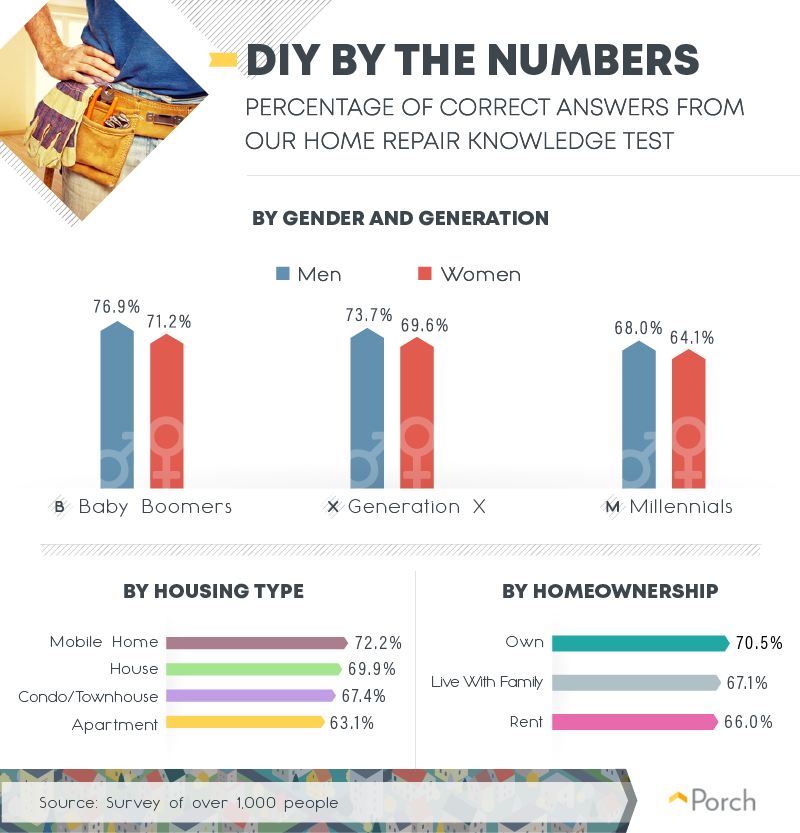Call it the HGTV effect, or blame the viral influence of Pinterest. Young Americans are increasingly interested in home improvement, whatever the reason, and many are taking matters into their own hands. According to one recent survey, millennial homeowners now spend about $26,000 annually for home upgrades each year. And much of that spending is for DIY projects: Retailers have seen an uptick in purchases among young customers buying supplies.
But does this enthusiasm translate to real home improvement know-how? After all, older generations are always faulting millennials for their lack of humility and focus, essential ingredients for DIY success. Can baby boomers and Gen Xers still teach the digital generation a thing or two about homeownership?
We decided to find out, asking members of each generation to assess their handiness around the house. We then put their assertions to the test, asking which repairs they’ve actually done. Finally, we quizzed them on basic home maintenance knowledge to see who possesses the real expertise. Our findings? Millennials think they’re adept at a variety of home improvement tasks—but in experience and knowledge, the numbers show differently.
Each Generation’s Self-Perceived Skills

While a significant portion of each generation claimed it was pretty handy, no group touted its home improvement skills more highly than millennials. This confidence was particularly apparent among that generation’s men, of which 78.6 percent identified as handy. By contrast, fewer than 70 percent of Gen X and baby boomer men said the same. Similarly, a greater percentage of millennial women claimed the “handy” mantle than in any other generation.

Based on millennials’ self-assessment of their skills, their generation’s reputation for being hopeless at home maintenance may be unwarranted. Young Americans have held off on buying homes longer than generations prior, so they may be used to calling someone else to handle maintenance. Indeed, among respondents, millennials had far lower rates of homeownership than older generations—leading us to wonder how they learned the handy skills they claim to have.
Are millennials exaggerating their proficiency when it comes to repairs, or do they get too little credit when it comes to practical skills? To find out, we ask for more detail about their handy habits, including who takes the lead when something breaks.
Who Fixes It?

When something at home stops working, calling a professional can spare stress and uncertainty. But for the majority of millennials, that path seemed too easy—or costly. Fifty-five percent preferred to handle repairs themselves, compared to roughly 43 percent of baby boomers and Gen Xers. Home improvement retailers are hoping this DIY ethic persists among millennials as millions leap to homeownership after holding off for years.
Gen Xers, conversely, relied on their spouse or partner for repairs more often than other generations did. Baby boomers were the most likely to hire a professional, though, perhaps because they’re growing old enough to be more hesitant to safely perform some repairs themselves. Recently, contractors nationwide have benefited from a surge in baby boomers remodeling their homes to accommodate them better as they age.
Comparing Repair Resumes

Calling oneself handy is one thing, but acquiring a record of successful fixes is another. When we asked each generation what repairs they’d performed in the past, millennials had the most limited track record, despite their self-professed competence. In fact, for 13 of the 21 repairs studied, millennials had the least experience. When they did surpass other generations, it was often due to their superior tech savvy: They were most likely to have set up a wireless router and mounted a TV, for instance. Millennials were also more likely than their older counterparts to perform some other varieties of “adulting” unrelated to home repairs, such as an oil change or cooking for a dinner party.
It might be easy to dismiss the gulf between millennials’ DIY confidence and their experience as mere arrogance. But perhaps older generations have simply had more time to experience all the challenges of homeownership and reassess their own skills accordingly. After all, if you’re only familiar with simple fixes like installing a showerhead, you might draw the erroneous conclusion that all home repairs are as easy. So in addition to quizzing participants on what they have done in the past, we asked them what they knew about home repairs.
Bungling the Basics?

To further study differences in DIY project knowledge among generations, we quizzed respondents on basic facts that informed home improvement projects. In this regard, nearly 1 in 5 millennials could not correctly identify the difference between a flat head and a Phillips head screwdriver. Among baby boomers, by contrast, less than 10 percent made this error. Even on slightly more difficult subjects, like naming the purpose of an auger bit, the oldest generation surpassed younger counterparts. Nearly two-thirds of baby boomers could do so successfully, compared to just 61.2 percent of Gen Xers and 51.4 percent of millennials.
Younger folks did outperform older Americans in one respect, however: knowledge of the metric system. Among Gen Xers and millennials, about 7 in 10 correctly identified the number of millimeters in a centimeter, whereas a smaller portion of baby boomers answered this correctly. Perhaps we can cut them some slack: It’s been several decades since baby boomers may have absorbed this content in grade school.
Toolkit Troubles

Individuals with repair experience should at least be capable of naming common DIY tools, even if they’re less than an expert in wielding them. Sadly, sizeable segments of millennials could not identify a range of common instruments: Just 73 percent could correctly name a C-clamp, and even fewer knew what to call a hacksaw. Here, knowledge improved with age in all cases. Gen Xers were slightly better at naming every tool, and baby boomers were the best.
Even when asked to identify the purpose of a Spackle knife, just 84.2 percent of millennials could do it. Compare that to 93.3 percent of baby boomers, and the future of America’s walls starts to look a little grim. Millennials were more inclined to guess the tool was used in painting than other generations, perhaps confusing it with the more slender painting knives often used by television’s favorite painting instructor, Bob Ross.
The Demographics of DIY Knowledge

When we consider the results of our quiz in their entirety, it’s clear DIY knowledge declined with each successive generation. This was true among both men and women, as each gender experienced an inverse correlation between knowledge and youth. Regarding both know-how and experience, millennials overstated their DIY abilities when asked if they were handy.
Interestingly, those who lived in mobile homes scored best on our DIY knowledge quiz, outperforming even those who lived in houses. Given the special difficulties that upkeep of a mobile home can entail, perhaps we shouldn’t be surprised that this group was well-informed. Homeownership of any kind was associated with higher scores. In fact, those who rented performed even worse than those who lived with their family. Perhaps that cohort is forced to make repairs around the house rather than chipping in on rent.
No Shame in Calling in the Experts
So maybe some of us tend to overestimate our skills around the home—if your DIY optimism turns disastrous, applaud yourself for the initiative at least. As with any other skill, repairing or remodeling a home requires practice, which you can only gain by making a mess or two. But when things start to get overwhelming, don’t let pride prevent you from getting the professional assistance you need. After all, doing it yourself doesn’t feel so great when the job’s done wrong.
Of course, when you call in the pros, you want to make sure they have more experience and skill than you do. That’s where Porch comes in, with competitive quotes from trusted home improvement professionals. We even offer handy cost estimates for common projects so that you can budget with confidence. Sometimes the only thing better than doing it yourself is realizing you don’t have to.
Methodology
To compile the data above, we surveyed 1,010 respondents aged 18 and older from Amazon’s Mechanical Turk. The participant gender breakdown totaled 540 women, 469 men, and one individual who identified as neither. Because the data we present rely on self-reported abilities and histories, they may not be perfectly representative samples of all generations and genders. These data are meant solely for entertainment purposes, although we made every effort to represent the data as accurately as possible.
Fair Use Statement
Feel free to use our images and information for noncommercial purposes. When you do, we hope you’ll attribute us by providing a link back to this page. As all DIYers can attest, it feels good to get some credit for your work.
Sources
- https://finance.yahoo.com/news/millennials-obsessed-hgtv-205022165.html
- https://business.pinterest.com/en/blog/pinterest-millennials-guide-to-life
- https://www.cnbc.com/2017/05/04/millennials-and-first-time-homebuyers-spend-lots-more-on-renovations-survey.html
- https://www.cnbc.com/2017/11/14/home-depot-is-retails-bright-spot-with-help-of-diy.html
- https://www.forbes.com/sites/carolinebeaton/2017/01/06/top-employers-say-millennials-need-these-4-skills-in-2017/#33c2cf07fe43
- https://www.realtor.com/advice/home-improvement/home-maintenance-skills-millennials-should-know/
- http://www.businessinsider.com/home-depot-millennials-housing-household-formation-2017-8
- http://www.businessinsider.com/home-depot-millennials-housing-household-formation-2017-8
- https://apnews.com/24caf2da41bc4259a11f480fc43b3b94
- http://time.com/4361866/adulting-definition-meaning/
- https://www.thoughtco.com/learn-how-to-paint-with-a-knife-2578778
- https://www.artsupplywarehouse.com/finelineDisplay.php?id=153020
- https://www.doityourself.com/stry/mobilehometips

